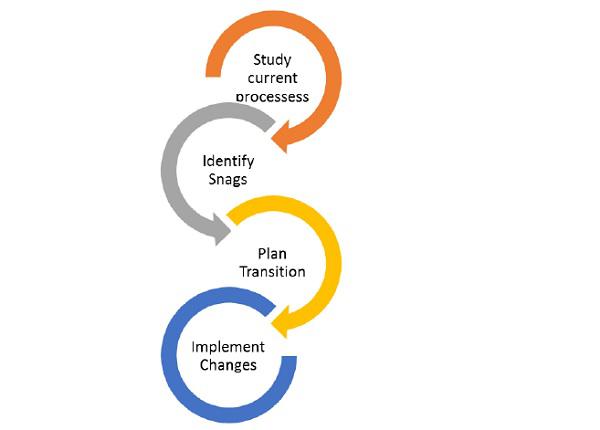Organizational Change Management
When organizations undertake initiative to improve performance, seize opportunities or address key issues, they often require changes − changes to processes, job roles, organizational structure, and types and use of technology.
Change Management
It is the discipline that guides, prepares, and equips organizations to successfully adopt change in order to drive organizational success.
It provides a structured approach for supporting the employees in moving forward from their current state to desirable and progressive future state.
Planning Organizational Change
Organizational change often, if not always, is an indicator of potential problems or issues with the organization. In some cases, however, voluntary changes happen in forward looking organizations that proactively recognize potential opportunities or situations.
Whatever the case, change is a shift from the current comfort state for any organization and needs to be well planned so as to not imbalance the current environment.Key steps in the process of implementing a planned organizational change is depicted in the following figure.
Organizations need to undertake thorough study to understand the existing processes and procedures, and identify the snags. Each problem area has to be evaluated and the changes required for improvement have to be assessed.

The next step is to determine the desired future state the management wishes the organization to be in. This will need to be communicated to all concerned and design the means of smooth transition.
The transition plan once finalized has to be implemented in an orderly manner. Plans have to be made and resources need to be allocated. Responsibility has to be assigned to a key person in the organization to take charge of the change process. It is essential for the top management to be involved in the whole process to direct and govern the process.
Resistance to Changes
Organizational change is sometimes unavoidable. It is a complex process that affects the organization all across. Not all employees and departments welcome changes to their existing environment and processes. It is normal human reaction to defend the status quo if security or status is threatened.
In fact, organizational change can generate skepticism and resistance in employees, making it sometimes difficult or impossible to implement organizational improvements. This makes the role of the management even more critical, to make an effort to support the employees during and even after the process of transformation.
Managing resistance to change is challenging. Some reasons why change is resisted in organizations are −
Impact of Change
Employees resist change if it is not favorable to them. They tend to be more welcoming of changes that are favorable to them and empower them. Resistance also happens when change is thrust onto people without giving them adequate warning and without helping them through the process of understanding what the change will entail and how it will impact their jobs/work.
Self-Interest Before Organizational Well-being
Some employees resist changes as it comes in the way of their personal interest and agenda. They fear that the change will delay or obstruct the fulfillment of their hidden agenda.
Personality Trait
Some are inherently more resistant to any kind of change than others. Employees having a positive and optimistic approach are more willing to accept changes than employees who have a negative approach.
Uncertainty
Change often brings feelings of uncertainty as the end result is usually unknown. The environment after transformation could change for the better or sometimes worse than it was earlier. This lack of clarity creates insecurity in employees as it leads to a sense of loss of control.
Fear of Failure
Changes in the work processes can create uncertainty over their capabilities in employees as they fear that they may not be able to adapt to the new requirements. Thus employees who are confident of their abilities and performance are more likely to welcome the proposed change, than those who have lower confidence.
Fear of Job Loss
Another important factor that causes employees to resist change is the fear that they may lose their job in the organization once the transformation is affected. This usually happens in organizations that undertake restructuring or downsizing as a major cause of the change.
Overcoming Resistance to Change
Implementing change is always difficult for organizations. But the transition can be made smooth if the management goes through it with empathy and compassion after thorough analysis, planning, and strategizing.
The top management must fully understand how change works in order to lead their organizations successfully into the future. The introduction and management of change are emerging as two of the most critical elements of leadership for the future.
Address Employee Concerns
A management that is truly concerned about its employees will address and deal with the concerns of the employees first, by giving them confidence and assuring that the change will bring positive results and then focus on the organizational benefits.
Effective Communication
A good leader is also an effective communicator. As a change agent, the leader rather than communicating with the employees what they stand to gain from the change, can have a greater impact by telling them what they stand to lose if they don’t accept the change.
Creating an Atmosphere of Trust
Exercises such as teambuilding, trust-building, and open and honest communication with the employees prior to the introduction of change will help create an atmosphere of trust. If employees are involved in the change process and their inputs sought, it will help them accept the changes implemented without fear.
Link Changes to Employee Concerns
Employees’ perception of change can be made positive and welcoming by associating the need for change to other issues that they are concerned about like issues of health, job security, and better working atmosphere.



